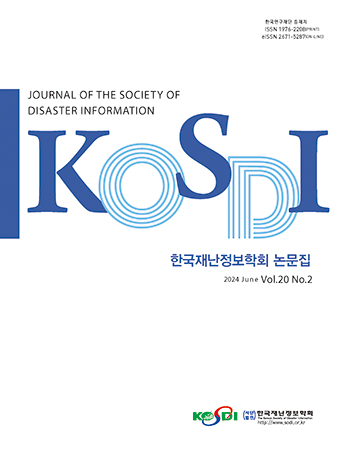Original Article
Abstract
References
Information
Purpose: In order to maximize the stability and productivity of the work through simulation prior to high-risk facilities and high-cost work such as dismantling the facilities inside the reactor, we intend to use digital twin technology that can be closely controlled by simulating the specifications of the actual control equipment. Motion control errors, which can be caused by the time gap between precision control equipment and simulation in applying digital twin technology, can cause hazards such as collisions between hazardous facilities and control equipment. In order to eliminate and control these situations, prior research is needed. Method: Unity 3D is currently the most popular engine used to develop simulations. However, there are control errors that can be caused by time correction within Unity 3D engines. The error is expected in many environments and may vary depending on the development environment, such as system specifications. To demonstrate this, we develop crash simulations using Unity 3D engines, which conduct collision experiments under various conditions, organize and analyze the resulting results, and derive tolerances for precision control equipment based on them. Result: In experiments with collision experiment simulation, the time correction in 1/1000 seconds of an engine internal function call results in a unit-hour distance error in the movement control of the collision objects and the distance error is proportional to the velocity of the collision. Conclusion: Remote decomposition simulators using digital twin technology are considered to require limitations of the speed of movement according to the required precision of the precision control devices in the hardware and software environment and manual control. In addition, the size of modeling data such as system development environment, hardware specifications and simulations imitated control equipment and facilities must also be taken into account, available and acceptable errors of operational control equipment and the speed required of work.
연구목적: 원자로 내부 시설물 해체 등의 고위험 시설이나 고비용 작업에 앞서 시뮬레이션을 통한 작업의 안정성과 생산성을 최대화하기 위해 실제 제어 장비의 제원을 시뮬레이션 상에 모사하고 이를 통해 정밀 제어될 수 있는 디지털 트윈 기술을 이용하고자 한다. 디지털 트윈 기술을 적용함에 정밀 제어 장비와 시뮬레이션의 시간적 격차로 인해 발생할 수 있는 동작 제어 오차는 위험 시설물과 제어 장비 간의 충돌 등과 같은 위험 요소들을 발생시킬 수 있다. 이러한 상황을 제거하고 통제하기 위해서는 사전 연구가 필요하다. 연구방법: 현재 시뮬레이션을 개발함에 가장 대중적으로 사용되는 엔진으로는 Unity 3D가 있다. 하지만 Unity 3D 엔진 내부의 시간 보정으로 인해 발생할 수 있는 제어 오차가 존재한다. 그 오차는 여러 환경에 예상되고 그 오차는 시스템 사양 등의 개발 환경에 따라 다를 수 있다. 이를 입증하기 위해 Unity 3D 엔진을 이용하여 충돌 시뮬레이션 개발하고 이를 통해 다양한 조건의 충돌실험을 진행하고 그에 따른 결과를 정리하고 분석하여 이를 토대로 정밀 제어 장비의 허용 오차를 도출한다. 연구결과: 충돌실험 시뮬레이션을 통한 실험에서 엔진 내부 함수호출에 1/1000초 단위의 시간 보정으로 인해 충돌체의 이동제어에 단위 시간당 거리오차가 발생하고 거리오차는 충돌체의 이동속도와 비례한다. 결론: 디지털 트윈을 이용한 원격해체 시뮬레이터는 하드웨어와 소프트웨어 환경과 수동 제어 시 정밀 제어 장치의 요구 정밀도에 따른 이동속도의 제한이 필요할 것으로 판단된다. 그리고 운용 제어 장비의 가용 및 허용 오차와 작업의 요구 속도를 시스템 개발 환경, 하드웨어 사양과 시뮬레이션에 모사된 제어 장비 및 시설물 등의 모델링 데이터의 크기도 반드시 고려한다.
- Chabal, C., Mante, J.F., Idasiak, J.M. (2011). "Virtual reality technologies: A way to verify and design dismantling operations, first application case in a highly radioactive cell." International Journal on Advances in Intelligent Systems, Vol. 4, No. 3&4, pp. 343-356.
- Choi, H.-W., Kang, S.-M., Kim, K.-J., Kim, D.-Y., Choung, Y.-J. (2015). "Development of the visualization prototype of radar rainfall data using the unity 3D engine." Journal of the Korean Association of Geographic Information Studies, Vol. 18, No. 4, pp. 131-144. 10.11108/kagis.2015.18.4.131
- Fan, W., Lee, C.-H., Chen, J.-H. (2016). "Real-time repairable interpolation scheme for CNC tool path processing." International Journal of Precision Engineering and Manufacturing, Vol. 17, No. 12, pp. 1673-1684. 10.1007/s12541-016-0194-6
- Kim, H.J., Kim, H.-S, Kim, W.-T. (2018). "The human digital twin architecture for Human-In-the-Loop system." Proceedings of Symposium of the Korean Institute of Communications and Information Sciences, 2018, Vol. 1, pp. 631-632.
- Kim, M.-S., Sung, N.-J., Choi, Y.-J., Hong, M. (2017). "Performance comparison of particle simulation using GPU between OpenGL and unity." KIPS transactions. Software and data engineering, Vol. 6, No. 10, pp. 479-486.
- Kim, M.-S., Song, W., Choi, Y.-J., Hong, M. (2018). "Real-time collision response between cloth and sphere object in unity." Journal of Internet Computing and Services, Vol. 19, No. 6, pp. 53-62.
- Lee, E.-h., Kim, C.-L. (2019). "Radiological impact on decommissioning workers of operating multi-unit NPP." Journal of Nuclear Fuel Cycle and Waste Technology(JNFCWT), Vol. 17, No. 1, pp. 107-120. 10.7733/jnfcwt.2019.17.1.107
- Lee, K.-S. (2019). "A study of spiderwebs via unity physics engine." School Science Journal, Vol. 13, No. 3, pp. 261-270.
- Song, S.-M., Lee, S.-J., Jeon, J.-W. (2013). "Real-time correction system for improving the disparity image." 13th International Conference on Control, Automation and Systems (ICCAS 2013). pp. 1138-1142. 10.1109/ICCAS.2013.6704088
- Publisher :The Korean Society of Disaster Information
- Publisher(Ko) :한국재난정보학회
- Journal Title :Journal of the Society of Disaster Information
- Journal Title(Ko) :한국재난정보학회논문집
- Volume : 16
- No :4
- Pages :813-823
- DOI :https://doi.org/10.15683/kosdi.2020.12.31.813




 Journal of the Society of Disaster Information
Journal of the Society of Disaster Information







